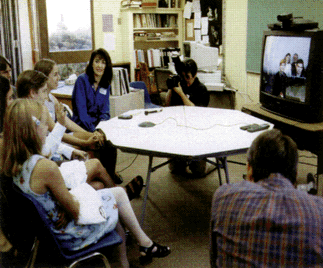Improving Education
U.S. and Ukrainian Student Exchange
|
US Dept of Energy 19901 Germantown Road Germantown, MD 20874 (301) 903-0234 |
The Internet and satellite technology have helped forge a working relationship between students living near the Hanford nuclear site in Richland, Washington, and near the Chornobyl nuclear power plant in Slavutych, Ukraine. Communicating by fax and e-mail, the American and Ukrainian students created a joint World Wide Web site (see http://www.chornobyl.org/exchange/) about their communities' histories, economies, and environmental issues. Pacific Northwest National Laboratory provided computer and e-mail access to the students in Richland and Slavutych, along with technical assistance in developing the web site.
After creating their Internet site, the students "met" through a satellite videoconference, enabling them to ask questions about one other. The exchange was so successful that Battelle Memorial Institute offered to send two students from each team to visit the others' families and home cities. The visits took place in December 1997. The exchange has reaped benefits for the U.S. and Ukrainian experts who are addressing safety problems at Chornobyl. "The fact that we're willing to go beyond the technical aspects of our jobs and get to know one another's families has deepened our working relationship and improved our understanding of one another," said Roger Anderson, a program manager for Pacific Northwest National Laboratory, which Battelle operates for the U.S. Department of Energy. Pacific Northwest National Laboratory provides technical leadership for the U.S. Department of Energy's work to reduce risks at Soviet-designed nuclear power plants. The students also benefited from the exchange, developing skills in research, project management and technology, said the American students' teacher, Maureen McQuerry. They "found they share more similarities than differences with the Ukrainians," she said. "Richland and Slavutych were both formed by the nuclear industry. The students in Slavutych and their families worry about some of the same things we worry about, such as employment and environmental cleanup. We also learned that teenagers are teenagers the world over--they have a lot of mutual interests." McQuerry worked with staff at Pacific Northwest National Laboratory to develop the exchange program. Nadia Neretina, an English teacher in Slavutych, worked with the Ukrainian teenagers, who wrote about themselves and their communities in English. The student teams spent several months collecting information about their communities and developing the web site. The students' July 1997 videoconference inaugurated the satellite-based videoconferencing link between the Pacific Northwest National Laboratory and the Chornobyl Center for Nuclear Safety, Radioactive Waste and Radioecology in Slavutych. The U.S. Department of Energy installed the communications technology in Slavutych to improve international collaboration on Chornobyl's nuclear safety problems. Attending the students' videoconference were the mayors of Richland and Slavutych, as well as representatives from the U.S. Department of Energy and Pacific Northwest National Laboratory. Battelle Memorial Institute provided the money to send two Richland students and their teacher to Slavutych for two weeks, then bring two Slavutych students and their teacher to Richland for two weeks. Both exchanges used a buddy system, matching a visiting student to a host student to help the visitors become more involved in the host students' culture and peer group. The visitors accompanied the host students to classes and school activities. They also attended cultural and sports events, toured the region's sites, and filed e-mail reports with classmates back home. The Ukrainian students were interviewed by Richland television, radio, and newspaper reporters. The American students visited the Chornobyl site and the townsite of Pripyat, abandoned after the 1986 nuclear accident. The exchange fostered in the students a world-wide perspective and understanding, challenging their "us" and "them" view of the world. |
